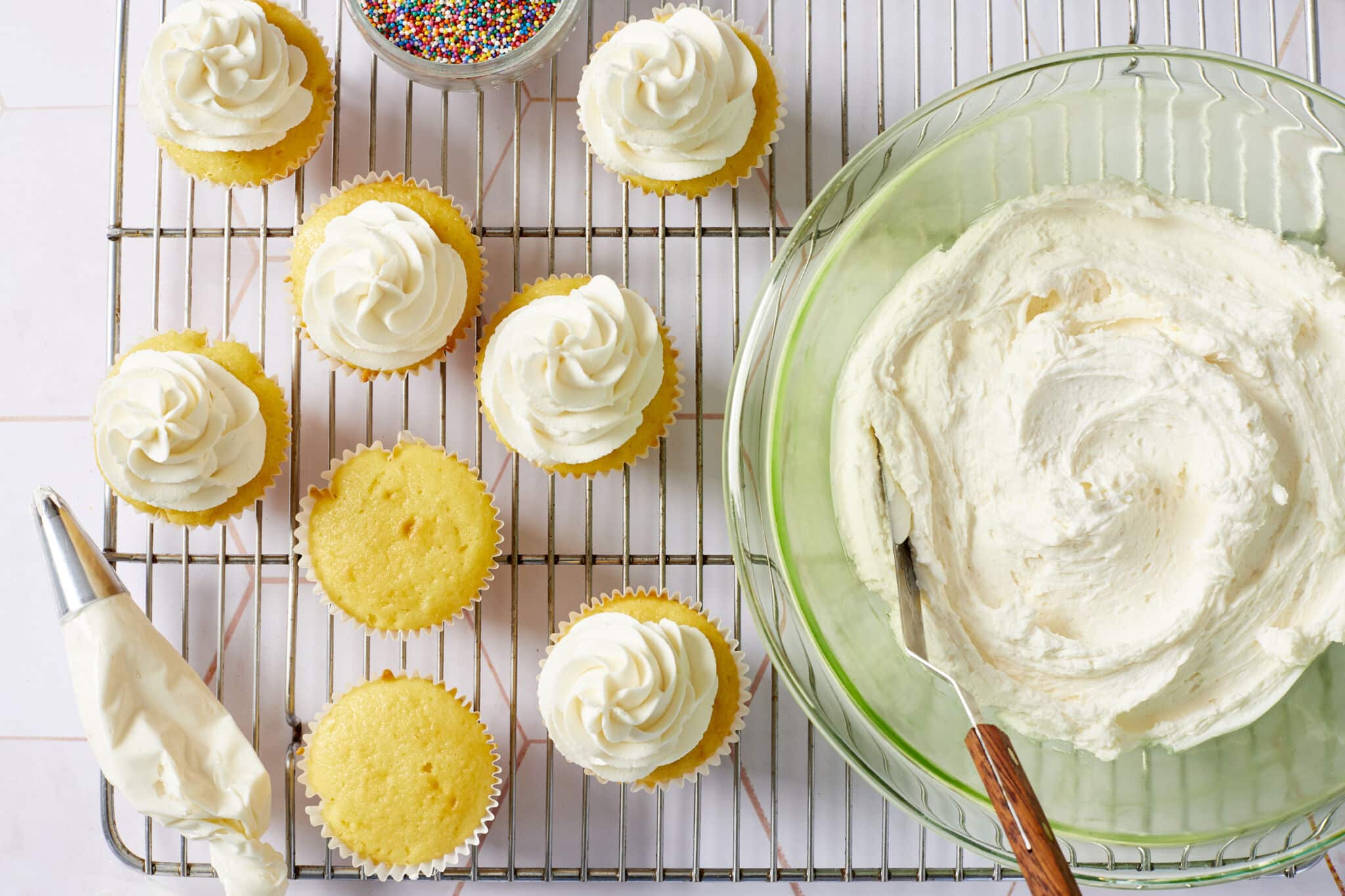
This post may contain affiliate links. Please see my full disclosure for details.
Hi Bold Bakers!
WHY YOU WILL LOVE THIS RECIPE: Nothing beats a great homemade vanilla buttercream frosting recipe, and every baker should have a foolproofbuttercream recipe in their back pocket to decorate cakes and cupcakes. Here’s the thing though, this recipe is so good that I just had to call it the Best-Ever. Bold Bakers say it’s delicious, with a sweet, but not too sweet! taste, and has the best creamy texture. I mean, just look at all those reviews like:
“It is now my go-to frosting! I’ve never had any failures in making it. Thanks for the easy-to-follow directions.”
“This buttercream is beautifully fluffy and delicious, and pipes dreamily!”
As a professional chef, I have learned a lot of tips and tricks over the years. Now I’m going to show you the Bold Baking Basic recipe that I get the most requests for How to Make the Best- Ever Vanilla Buttercream Frosting. Watch the step-by-step video below (along with a complete recipe!) and get all my best tips on how to make the icing.
IMPORTANT NOTE: This recipe was updated and improved on 4/19/2023 to include additional detailed tips on ingredients and process, step-by-step photography, answers to the most frequently asked questions (why runny/grainy, less sweet, etc) and Pro-Chef Tips.
Table of Contents
- What is Buttercream Frosting?
- The Secret to My Best-Ever Vanilla Buttercream Frosting
- Tools You Need
- Best-Ever Buttercream Frosting Ingredients
- How to Make the Best Buttercream Frosting
- How to Store Vanilla Buttercream Frosting
- Why is my Buttercream Frosting Runny?
- Why is my Buttercream Frosting Grainy?
- Can I Cut Back on Sugar in Buttercream Frosting? How to Make Buttercream Frosting Less Sweet?
- FAQs
- Gemma’s Pro Chef Tips
- Try More Frosting Recipes!
What is Buttercream Frosting?
Buttercream frosting, also known as American buttercream frosting (there are other types, such as Swiss Meringue Buttercream) is made by whipping together butter, sugar, and other ingredients.
It sounds like it should be easy, but one of the most common questions I get asked on Bigger Bolder Baking is how to make successful buttercream frosting. I also had trouble with it for a very long time, but I developed the Best-Ever Vanilla Buttercream Frosting, and I have the tips that will give you foolproof results every time!
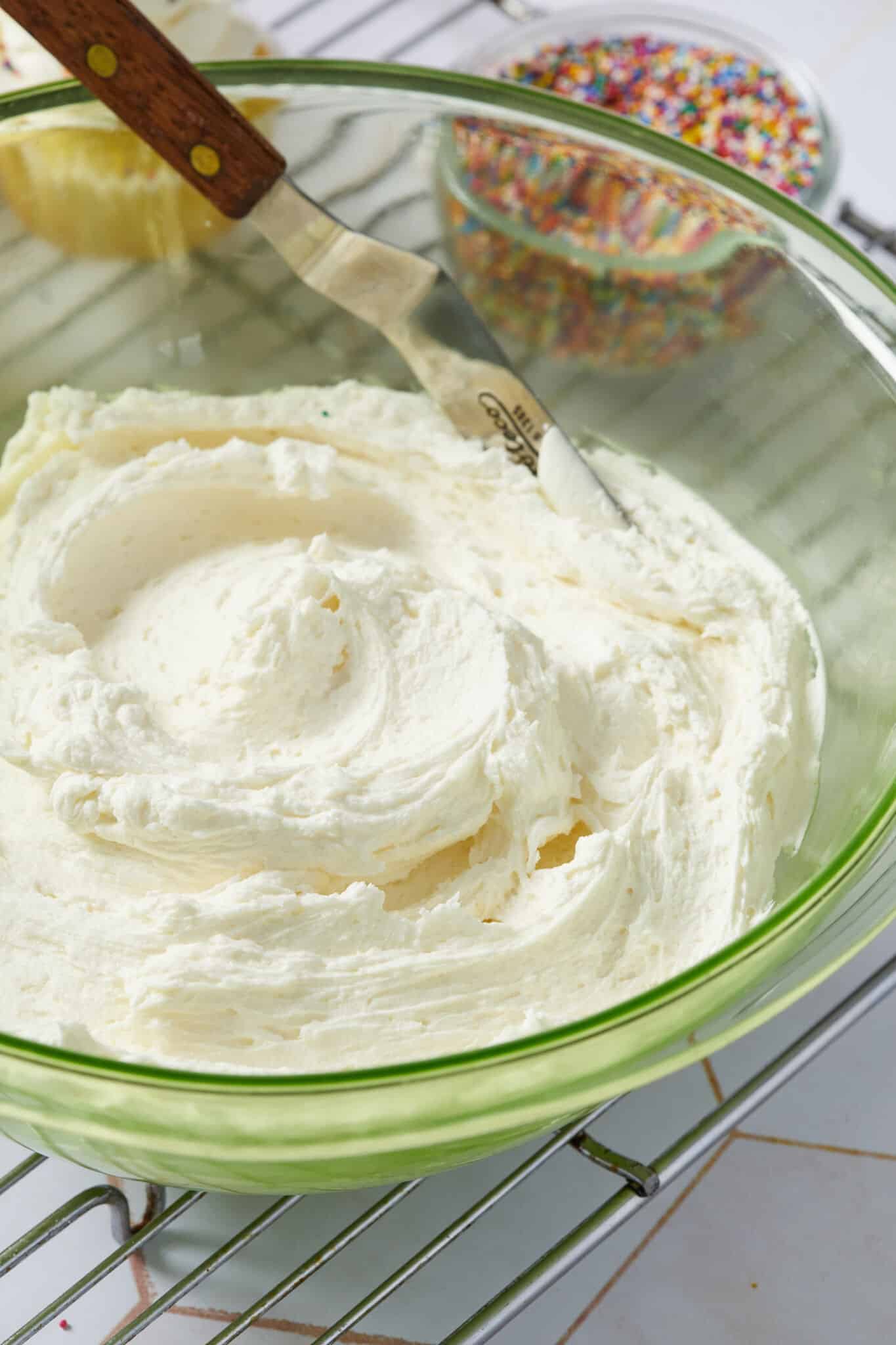
The Secret to My Best-Ever Vanilla Buttercream Frosting
How do you make fluffy homemade buttercream frosting? The secret ingredient in this recipe is time. Most people whip their butter for only a few minutes before adding in sugar, but you’ll never achieve a light and airy result this way. This frosting recipe takes its literal sweet time to really incorporate as much air as possible into the butter. Find detailed instructions on this page down below.
Tools You Need
- Measuring cups and spoons
- Stand mixer (use the whip attachment) or hand mixer
- Jug/liquid measuring cup
- Spatula
Best-Ever Buttercream Frosting Ingredients
Butter:
- Butter is the base of perfect buttercream frosting. I always use salted butter because salt enhances flavors. You can use either salted or unsalted butter per your preference.
- Butter has to be softened correctly to get the silky-smooth consistency for frosting. You know your butter is at the right temperature when you push the butter and it makes an indent, but your finger doesn’t easily squish right through.
Icing sugar (AKA powdered or confectioners sugar):
- Icing sugar is simply finely ground sugar with cornstarch added to absorb moisture to prevent clumping. The good news is if you run out of icing sugar, you can make your own using my How to Make Powdered Sugar recipe.
- Icing sugar not only perfectly sweetens frosting but also contributes to a smoother consistency compared to granulated sugar which is coarser.
- Icing sugar rubs against fat from softened butter during creaming, creating air pockets to incorporate air. In the meanwhile, icing sugar also coats air pockets to prevent them from drying out, retaining air to stabilize frosting.
Vanilla:
- I believe that using good quality ingredients is essential to making any great baked goods. Pure natural vanilla extract instead of artificial vanilla essence, is a must to deliver the signature flavor to your buttercream.
- You can make vanilla extract (and other flavor extracts) with amazing results at a fraction of the store price using my Homemade Extracts recipe.
- Vanilla bean paste will be more concentrated in flavor and yield a speckled effect.
Milk:
- Along with the vanilla, milk thins and lightens the consistency.
- Half and half, heavy cream, or heavy whipping cream will also work.
Food coloring (OPTIONAL)
- Gel food coloring can be used because it will not dilute the frosting consistency like liquid coloring does.
- Dip a toothpick in the paste and add it to the frosting in very small amounts each time.
How to Make the Best-Ever Vanilla Buttercream
While this recipe takes a bit of patience, follow my steps and you will have the best vanilla buttercream frosting every time (and don’t forget to get the full recipe with measurements, on the page down below):
1. Soften:
- The key to a fluffy buttercream frosting is perfectly softened butter. This is super-important because butter is the base of the frosting. Just leave your butter out at room temperature for around three hours, it will be at the perfect texture that when you push it makes an indent, but your finger doesn’t easily squish right through.
- Over-softened butter can not retain air well which leads to a flat runny frosting; under-softened butter will have lumps which leads to a grainy or overwhipped split frosting.
2. Whip:
- Using the whisk attachment instead of the paddle attachment can incorporate more air.
- Turn your mixer on a medium-high speed and whip the butter by itself for seven to eight minutes, until butter is light, fluffy, and pale yellow in color before you add in any sugar.
- Whipping up butter first will create an aerated structure to hold powdered sugar. Otherwise, sugar will weigh down the butter leading to a flat heavy frosting.
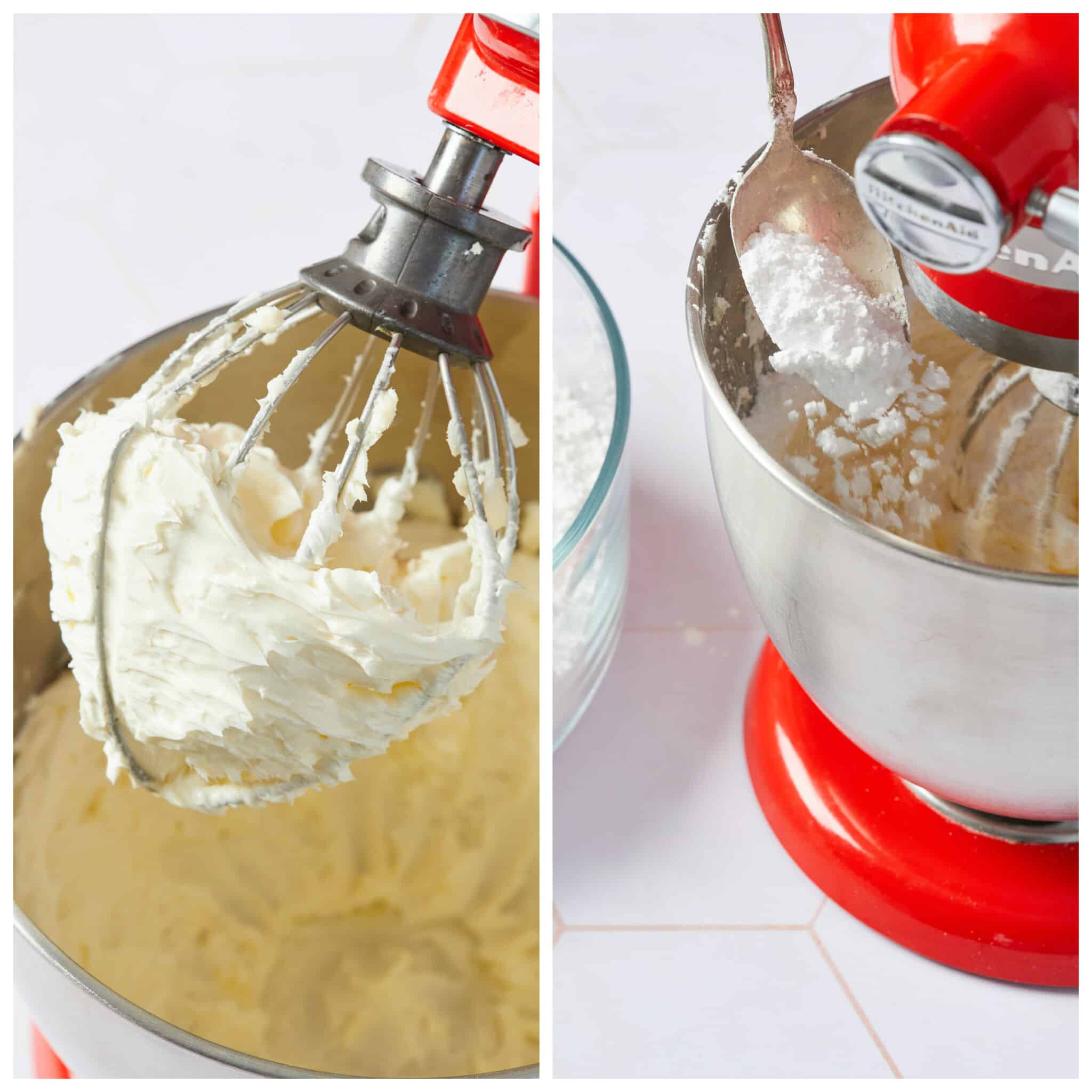
3. Sift:
- Sifting is really important when it comes to powdered sugar (or cocoa powder or almond flour in macarons to get out any lumps.
- Sifting will also fluff up the sugar and give you lighter frosting.
4. Sweeten:
- Once your butter is pale and light, add in your sugar spoonful by spoonful. Let each spoonful whip until fully incorporated before moving on to the next one.
5. Lighten:
- Add in the vanilla extract and milk, turn the machine back on high speed, and let everything incorporate. In just a few minutes, you will have perfect, fluffy frosting.
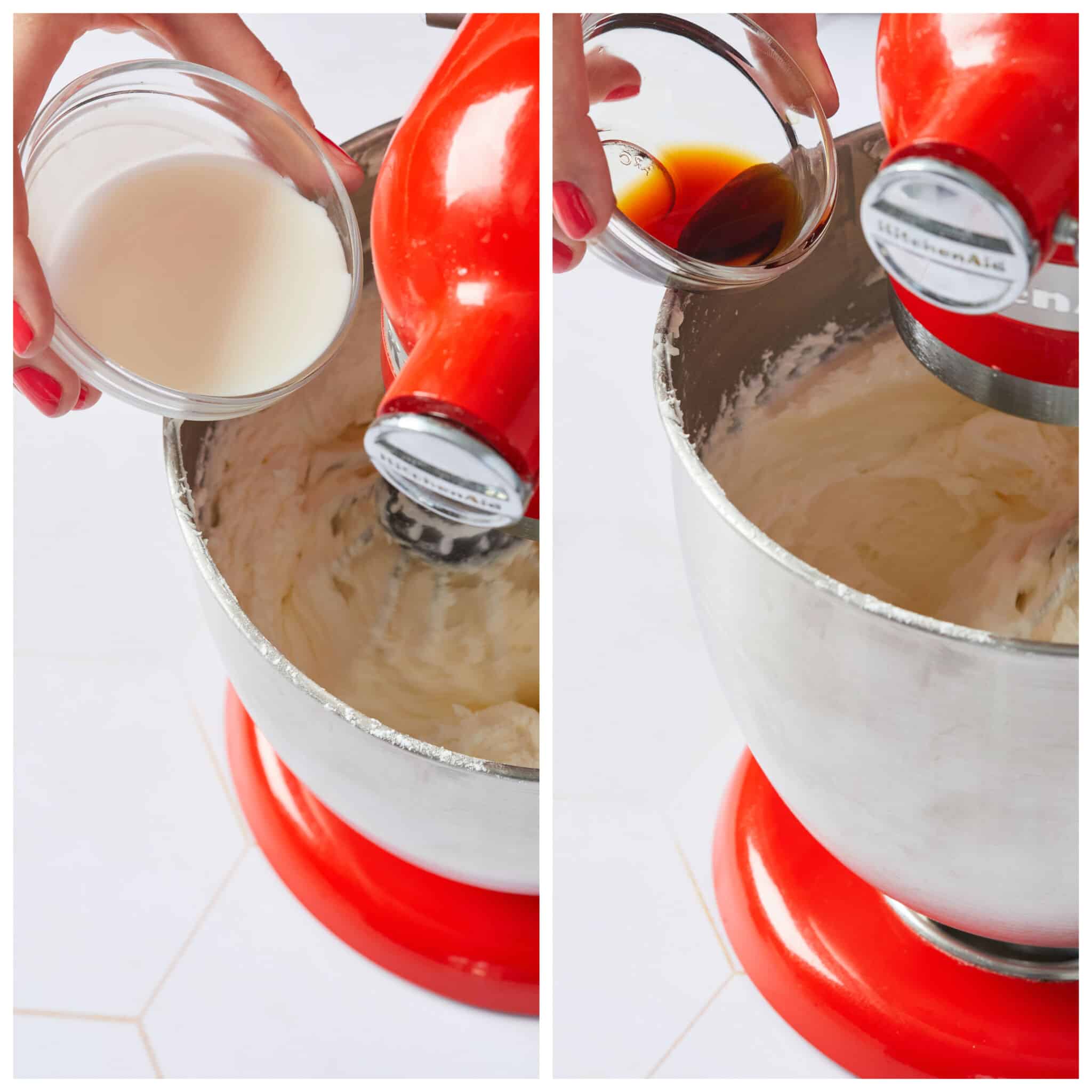
How to Store Best-Ever Vanilla Buttercream Frosting
The best way to store leftover buttercream frosting is to keep it in an airtight container in the refrigerator for up to 4 weeks.
Buttercream frosting can be frozen for up to 8 weeks.
Whether you’re storing it in the fridge or the freezer, make sure you keep it in an airtight container, pull it out, and let it come to room temperature naturally before you use it. Re-whip it until smooth again if needed.
Why is my Buttercream Frosting Runny?
- You might have overbeaten the butter which separated fat to cause the issue or your butter was too soft to retain air. You know your butter is at the right temperature when you push the butter and it makes an indent, but your finger doesn’t easily squish right through.
- Sugar was added too early which weighed down the mixture. Whip butter until light and fluffy to build a structure to hold the sugar. Otherwise, it would be runny.
- Sugar was added all at once which collapsed the mixture. Add sugar gradually to fully incorporate it. When sugar is beaten into the light and fluffy butter, it dissolves in the film on the surface of the air bubbles. This sugary syrup film prevents the bubbles from drying out and tightening up too fast.
- If it melted due to a hot weather, you can try my Stabilized Whipped Cream recipe or Ermine Frosting Recipe.
Why is my Buttercream Frosting Grainy?
- Butter was too cold which caused lumps. Make sure when you push the butter, it makes an indent, but your finger doesn’t easily squish right through.
- Granulated sugar was used. You need powdered / icing sugar which is fine enough to achieve a smooth result. Make it if needed using my How to Make Powdered Sugar recipe.
- Sugar was added all at once which clumped up. Add sugar gradually by spoonful to fully incorporate it.
- European Style Butter is high in fat and can yield a thick or potentially lumpy result. Add milk 1 tablespoon at a time to your Buttercream Frosting until you reach your desired consistency.
Can I Cut Back on Sugar in Buttercream? How to Make Buttercream Frosting Less Sweet?
- Sugar is vital in incorporating air into and stabilizing the structure of buttercream frosting. When sugar is beaten into the light and fluffy butter, it dissolves in the film on the surface of the air bubbles. This sugary syrup film prevents the bubbles from drying out and tightening up too fast.
- ¼ less is the farthest you can go without affecting the consistency.
- Another trick is to add 1-1 ½ teaspoons of lemon juice or 1 teaspoon of salt to reduce the sweetness.
FAQs
Can I double this recipe?
Yes, you can.
It is easy to adjust this recipe as it is proportional: it’s 4:1 in cups (two measures of sugar to one of butter) and 2:1 in weight (grams).
After adding vanilla, my frosting separated. Can it be fixed or do I start again?
It may be salvageable.
Your butter might have been over-softened so when you whipped it, it couldn’t retain much air and got over-whipped separating the fat. You can try to gently mix in more softened butter.
How do I get air bubbles out of the buttercream frosting?
Near the end of mixing, run your mixer at a low speed. This will help to smooth out the frosting and remove big air bubbles. While applying frosting, follow my guide on How to Do a Crumb Coat layer first.
How to frost small batch/single-serve recipes?
For about 3 mug cakes or 6 cupcakes, it would be 3 oz/85g of butter, 170g sugar, 1/2 tsp vanilla extract, 1 1/2 tsp- 2 1/4 tsp of milk and cream.
Gemma’s Pro Chef Tips
What do you do if you’ve followed my tips but find your frosting is too loose, and not thick enough for spreading or piping decorations?
- The first thing I’d suggest is to chill the buttercream frosting. By bringing down the temperature, the frosting should tighten up immediately. This is a great trick for buttercream frosting that may have been overmixed or made at too warm a temperature.
- If this doesn’t seem to do the trick, try adding more sifted powdered sugar, 3 tablespoons at a time.
If your frosting feels too thick, there is no reason to start over from scratch on a new batch.
- Simply add milk 1 tablespoon at a time until you reach the desired consistency. From there, simply pipe or frost as normal.
- Don’t worry, adding the milk will not affect the flavor of your frosting.
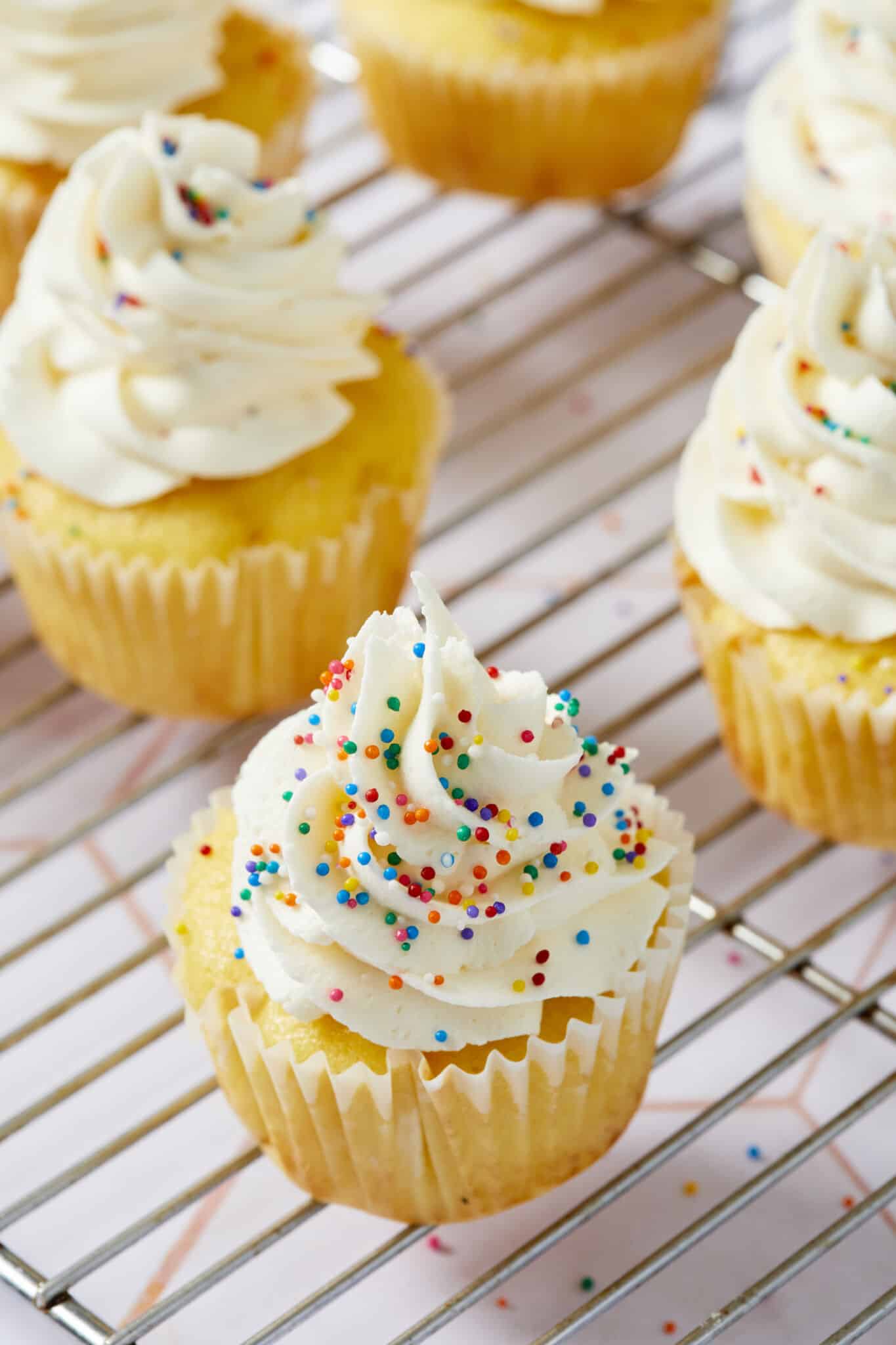
Ways to Use Vanilla Buttercream Frosting & More Flavors
- Gemma’s Best Vanilla Birthday Cake recipe or Gemma’s Best-Ever Vanilla Mug Cake This festive sprinkle-covered cake is the perfect choice for any Bold Baker. Make it in a mug for a quick dessert!
- Gemma’s Best Cake Recipes, Crazy Cupcakes, all your favorite mug cake recipes, and even sugar cookies!
- Lemon Cake With Lemon Buttercream Frosting
- White Velvet Cake with Strawberry Buttercream Frosting
- Best-Ever Chocolate Buttercream Frosting, Peanut Butter Buttercream Frosting, Fluffy Nutella Buttercream Frosting, Salted Caramel Swiss Meringue Buttercream and more possibilities!
Even More Frosting Recipes!
- Best-Ever Cream Cheese Frosting
- The Perfect Ermine Frosting
- Swiss Meringue Buttercream Frosting
- Vegan Chocolate Buttercream Frosting
- Dairy-Free Vanilla Buttercream Frosting
And don’t forget to check out my new cookbook, Bigger Bolder Baking Every Day!
IMPORTANT NOTE: This recipe was updated and improved on 4/19/2023 to include additional detailed tips on ingredients and process, step-by-step photography, answers to the most frequently asked questions (why runny/grainy, less sweet, etc) and Pro-Chef Tips.
Full (and printable) recipe below!
Watch The Recipe Video!
Gemma's Best-Ever Vanilla Buttercream Frosting Recipe
Ingredients
- 1½ cups (12 oz/340 g) butter , softened
- 6 cups (1lb 8oz/680 g) icing sugar (powdered sugar) , sifted
- 2-3 tablespoons whole milk
- 2 teaspoon vanilla extract
Instructions
- In a stand mixer fitted with the whisk attachment (or using an electric hand mixer) whip the butter until light and creamy for about 7 - 8 minutes on High speed.
- While the butter is whipping sieve the icing sugar about 3 times to remove lumps and incorporate air.
- Once the butter is pale in color and light slowly add in the sifted icing sugar one spoon at a time at Medium speed. Let the sugar fully incorporate before adding in more.
- Add the milk and vanilla extract and whip on High speed for another 3-4 minutes until very light, creamy, and fluffy.
- Use the buttercream straight away or keep it refrigerated for up to 4 weeks. Before use, make sure it comes to room temperature. It also can be frozen for up to 8 weeks.
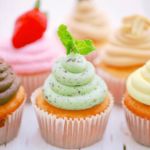
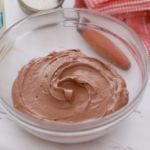
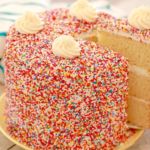
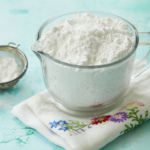
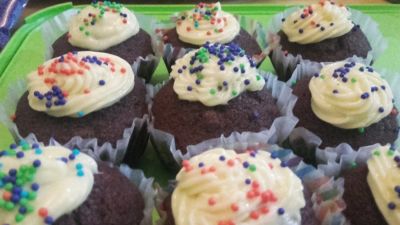
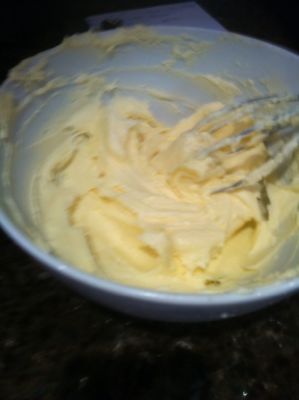
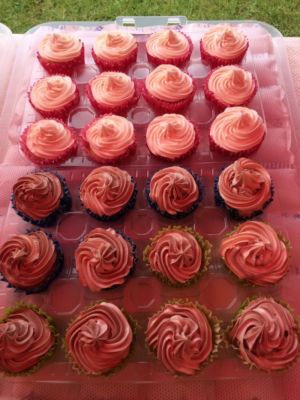
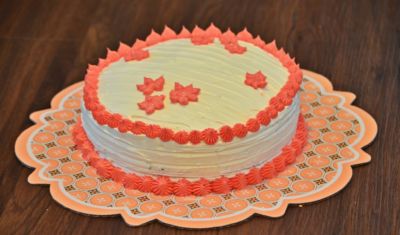
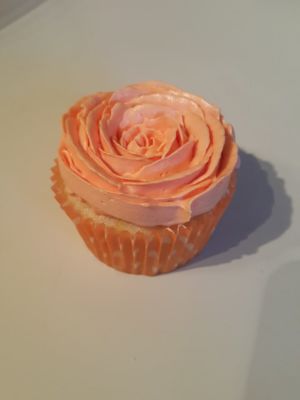
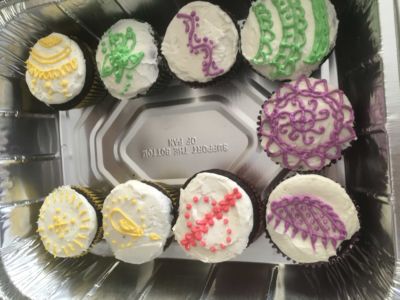
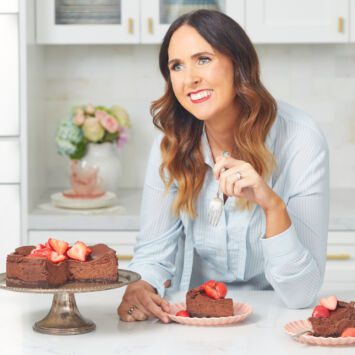


Hi Gemma,
Thank you for your recipes! I have made chocolate cake using your recipe and instead of chocolate fudge I made butter cream! Which turned out quite airy, light and sweet. But I didn’t put 6 cups of sugar, because I found it too sweet.
My question is. If it’s okay too use lees sugar?
Thank you.
I followed the recipe and it turned out amazing! This was my first time decorating a cake. Thoughts?
Hi Gemma,
I’m making a cake for my daughters birthday and I’m excited to try your butter cream frosting recipe. How long can the buttercream frosting stay out? I was hoping to assemble cake on Thursday evening and her party is Friday evening. Would it be ok to keep out or do you recommend putting in refrigerator? Also, I wanted to add some crushed Oreos into the frosting. Would you recommend mixing them in by hand after frosting is made or incorporating Oreos in stand mixer?
Thanks so much!!
Cindy Peterson 🙂
Hi Gemma Nazzy again,
I made your frosting and it stayed but i found out that when i add the colour it gets a bit lose as i have liquid colouring. then i add some more icing sugar.
also i have this problem, why does the frosting breaks while piping?
can u give a samll qty version of swiss meringue cream as i can use it to teast on piping?
i made my sons birthday cake” wheels on the bus” wanted to share with u.
Hi Gemma! Can I use salted butter in this recipe in place of salt?
Will this work if the sugar is skipped/replaced with a sweetener such as Stevia drops or erythritol? I imagine it would be ok in terms of the texture and consistency? Thoughts?
Hi yes you can double the recipe.
Flawless!
Hi Gemma,
I came across your website whilst looking for an easy vanilla frosting. I wanted a recipe that didn’t taste gritting with sugar, but wonder what I did wrong, however, it tasted grate and wasn’t as gritty as my usual buttercream recipe. I think it’s the butter, but how soft should the butter be to start mixing?
Thanks, Liddy
Hi, yes you can!